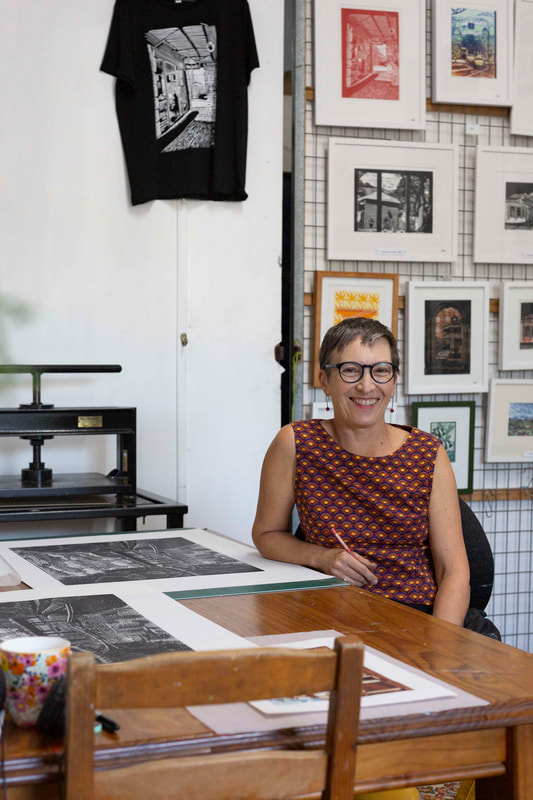If you know Sydney's inner west you will recognise these places in an instant. The Ming On warehouse, green with a decorative double fin sprouting up from the roof. The pink and mauve Marie Louise Salon on Enmore Road. The big old former metalworkers workshop at the beginning of King Street which used to house Gould Books. Each is a local landmark, capturing a slice of suburban history in and behind its facade.
In the prints collected in Disappearing Traders Maggie Stein turns her attention to landmark stores and structures of the inner west, celebrating their idiosyncratic details and anachronistic presence in the contemporary streetscape. They show a fond, familiar attention to these businesses and their proprietors, who are often synonymous with the businesses themselves.
This is certainly the case with Roger Shoe Repair in Redfern. The store is part of the strip of small shops along Redfern Street and is owned and operated by the larger-than-life Roger, who is well known for doing repairs for free if he thinks you deserve it. In 1990, when Maggie lived in Redfern, he would repair her kids' shoes for free, saying cheerfully: "keep your money for the children!" There are many such stories about Roger, and anyone entering Roger Shoe Repair comes away with a story as well as their shoes.
Disappearing Traders honours these small, everyday interactions, and the moments of exchange and connection that are the experience of shopping in these stores. In the early 2000s I would sometimes visit the Marie Louise Salon to have my hair cut. The salon was run by siblings George and Nola Mezher, and it was Nola who had trimmed my hair as her white cockatoo hopped over the backs of the salon chairs, and we chatted about how Newtown was changing. Gentrification was sweeping through King Street but up on Enmore Road there were still plentiful op shops and niche retailers, of which the Marie Louise, behind its pink exterior and its two display windows with a giant cardboard eye in each, was the star.
Traders such as the Marie Louise Salon or Roger Shoe Repair have endured through many decades and cycles of change. This is what ensures their notoriety, but also makes it all the more shocking when they do close down or relocate. Nothing is permanent, time moves on, fixtures shift. Now behind the Marie Louise facade is a restaurant, and you're more likely to see Roger's son behind the counter on Redfern Street. Other businesses, like Ming On or Gould's Books, have relocated from their signature premises, but still continue to trade.
Rarely do they disappear completely without trace. These places also live on through the attention of artists and writers who notice their significance and make works that record and remember them. The prints in Disappearing Traders connect with the stories that these buildings and businesses hold, celebrating the local and the familiar. They encourage us to remember these small, iconic places, even as they change, and the city changes around them.
In the prints collected in Disappearing Traders Maggie Stein turns her attention to landmark stores and structures of the inner west, celebrating their idiosyncratic details and anachronistic presence in the contemporary streetscape. They show a fond, familiar attention to these businesses and their proprietors, who are often synonymous with the businesses themselves.
This is certainly the case with Roger Shoe Repair in Redfern. The store is part of the strip of small shops along Redfern Street and is owned and operated by the larger-than-life Roger, who is well known for doing repairs for free if he thinks you deserve it. In 1990, when Maggie lived in Redfern, he would repair her kids' shoes for free, saying cheerfully: "keep your money for the children!" There are many such stories about Roger, and anyone entering Roger Shoe Repair comes away with a story as well as their shoes.
Disappearing Traders honours these small, everyday interactions, and the moments of exchange and connection that are the experience of shopping in these stores. In the early 2000s I would sometimes visit the Marie Louise Salon to have my hair cut. The salon was run by siblings George and Nola Mezher, and it was Nola who had trimmed my hair as her white cockatoo hopped over the backs of the salon chairs, and we chatted about how Newtown was changing. Gentrification was sweeping through King Street but up on Enmore Road there were still plentiful op shops and niche retailers, of which the Marie Louise, behind its pink exterior and its two display windows with a giant cardboard eye in each, was the star.
Traders such as the Marie Louise Salon or Roger Shoe Repair have endured through many decades and cycles of change. This is what ensures their notoriety, but also makes it all the more shocking when they do close down or relocate. Nothing is permanent, time moves on, fixtures shift. Now behind the Marie Louise facade is a restaurant, and you're more likely to see Roger's son behind the counter on Redfern Street. Other businesses, like Ming On or Gould's Books, have relocated from their signature premises, but still continue to trade.
Rarely do they disappear completely without trace. These places also live on through the attention of artists and writers who notice their significance and make works that record and remember them. The prints in Disappearing Traders connect with the stories that these buildings and businesses hold, celebrating the local and the familiar. They encourage us to remember these small, iconic places, even as they change, and the city changes around them.
